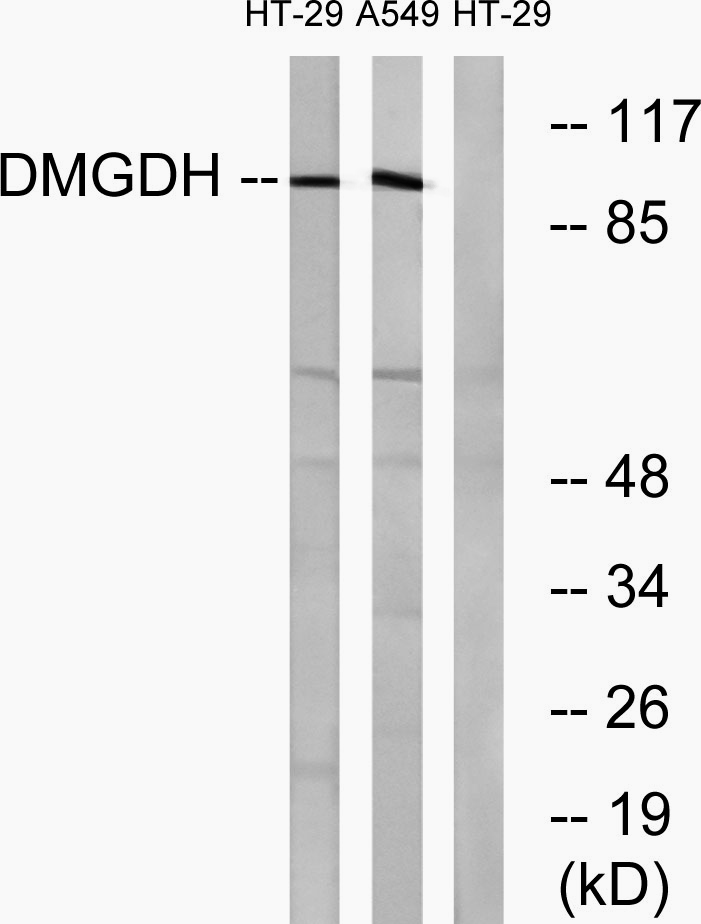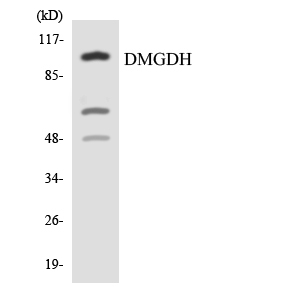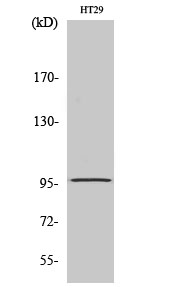产品名称
DMGDH Rabbit Polyclonal Antibody
别名
DMGDH; Dimethylglycine dehydrogenase; mitochondrial; ME2GLYDH
蛋白名称
Dimethylglycine dehydrogenase mitochondrial
存储缓冲液
Liquid in PBS containing 50% glycerol, 0.5% BSA and 0.02% New type preservative N.
Human Gene Link
http://www.ncbi.nlm.nih.gov/sites/entrez?db=gene&term=29958
Human Swissprot No.
Q9UI17
Human Swissprot Link
http://www.uniprot.org/uniprotkb/Q9UI17/entry
Mouse Swissprot No.
Q9DBT9
Mouse Swissprot Link
http://www.uniprot.org/uniprot/Q9DBT9
免疫原
The antiserum was produced against synthesized peptide derived from human DMGDH. AA range:817-866
特异性
DMGDH Polyclonal Antibody detects endogenous levels of DMGDH protein.
稀释度
WB 1:500 - 1:2000. IHC 1:100 - 1:300. ELISA: 1:20000.. IF 1:50-200
宿主
Polyclonal, Rabbit,IgG
背景介绍
This gene encodes an enzyme involved in the catabolism of choline, catalyzing the oxidative demethylation of dimethylglycine to form sarcosine. The enzyme is found as a monomer in the mitochondrial matrix, and uses flavin adenine dinucleotide and folate as cofactors. Mutation in this gene causes dimethylglycine dehydrogenase deficiency, characterized by a fishlike body odor, chronic muscle fatigue, and elevated levels of the muscle form of creatine kinase in serum. Alternative splicing results in multiple transcript variants. [provided by RefSeq, Jul 2013],
信号通路
Glycine; serine and threonine metabolism;
功能
catalytic activity:N,N-dimethylglycine + acceptor + H(2)O = sarcosine + formaldehyde + reduced acceptor.,cofactor:Binds 1 FAD covalently per monomer.,disease:Defects in DMGDH are the cause of DMGDH deficiency (DMGDHD) [MIM:605850]. DMGDHD is a disorder characterized by fish odor, muscle fatigue with increased serum creatine kinase. Biochemically it is characterized by an increase of N,N-dimethylglycine (DMG) in serum and urine.,pathway:Amine and polyamine degradation; betaine degradation; sarcosine from betaine: step 2/2.,similarity:Belongs to the gcvT family.,subunit:Monomer.,
纯化
The antibody was affinity-purified from rabbit antiserum by affinity-chromatography using epitope-specific immunogen.



